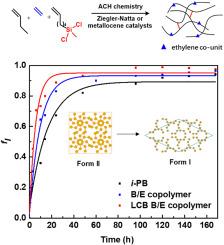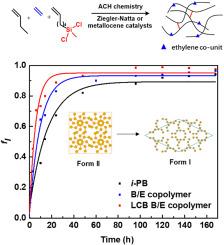Synthesis and performance study of Polybutene-1 synergistically engineered via H-Shaped long-chain-branching and ethylene co-monomer incorporation
IF 4.5
2区 化学
Q2 POLYMER SCIENCE
引用次数: 0
Abstract
This paper discusses the synthesis of H-shape long-chain-branched (LCB) 1-butene/ethylene copolymers via ω-alkenylmethyldichlorosilane copolymerization-hydrolysis (ACH) chemistry catalyzed by Ziegler-Natta and metallocene catalysts, where the LCB structures are joined by ethylene co-units to cooperatively modulate the sluggish Form II-I transition kinetics intrinsic to polybutene-1 (PB-1). The results reveal a synergistic effect between the two structural modifications in accelerating the Form II-I transformation. Such an enhancement proves substantially more pronounced with the metallocene catalyst system, where the conventionally 7-day transition period is shortened to within 24 h. Though ethylene incorporation disrupts chain regularity, reducing crystallinity and tensile modulus, it is found that LCB structures effectively counteract such destructive effects by enhancing nucleation and molecular chain entanglement. This research provides a new chemical approach to PB-1 modification that greatly improves its processing properties without significantly affecting mechanical properties.


h型长链支化与乙烯共聚单体协同工程聚丁烯-1的合成及性能研究
本文讨论了在Ziegler-Natta催化剂和茂金属催化剂催化下,通过甲基二氯硅烷共聚水解(ACH)化学合成h型长链支化(LCB) 1-丁烯/乙烯共聚物,其中LCB结构由乙烯共聚单元连接,协同调节聚丁烯-1 (PB-1)固有的缓慢的i - i - i型转变动力学。结果表明,两种结构修饰对加速i - i型相变具有协同效应。在茂金属催化剂体系中,这种增强效果更为明显,传统的7天过渡周期缩短到24小时以内。虽然乙烯掺入破坏了链的规则性,降低了结晶度和拉伸模量,但研究发现LCB结构通过增强成核和分子链纠缠有效地抵消了这种破坏作用。本研究为PB-1改性提供了一种新的化学方法,在不显著影响力学性能的情况下,大大提高了其加工性能。
本文章由计算机程序翻译,如有差异,请以英文原文为准。
求助全文
约1分钟内获得全文
求助全文
来源期刊

Polymer
化学-高分子科学
CiteScore
7.90
自引率
8.70%
发文量
959
审稿时长
32 days
期刊介绍:
Polymer is an interdisciplinary journal dedicated to publishing innovative and significant advances in Polymer Physics, Chemistry and Technology. We welcome submissions on polymer hybrids, nanocomposites, characterisation and self-assembly. Polymer also publishes work on the technological application of polymers in energy and optoelectronics.
The main scope is covered but not limited to the following core areas:
Polymer Materials
Nanocomposites and hybrid nanomaterials
Polymer blends, films, fibres, networks and porous materials
Physical Characterization
Characterisation, modelling and simulation* of molecular and materials properties in bulk, solution, and thin films
Polymer Engineering
Advanced multiscale processing methods
Polymer Synthesis, Modification and Self-assembly
Including designer polymer architectures, mechanisms and kinetics, and supramolecular polymerization
Technological Applications
Polymers for energy generation and storage
Polymer membranes for separation technology
Polymers for opto- and microelectronics.
 求助内容:
求助内容: 应助结果提醒方式:
应助结果提醒方式:


